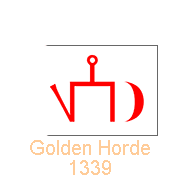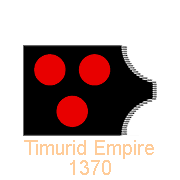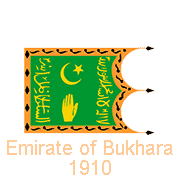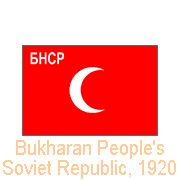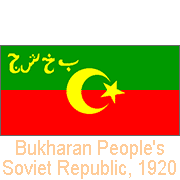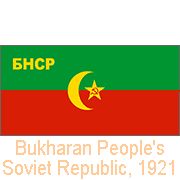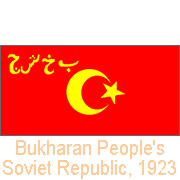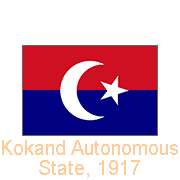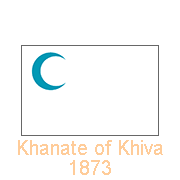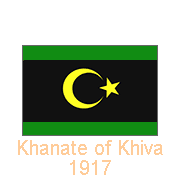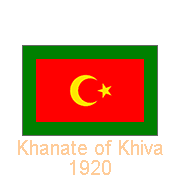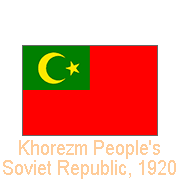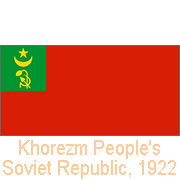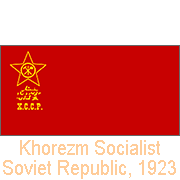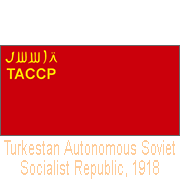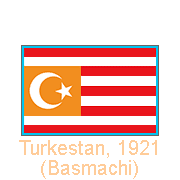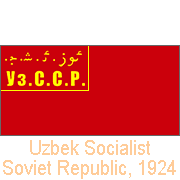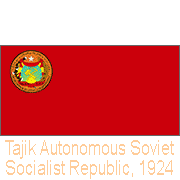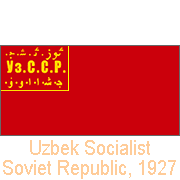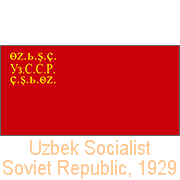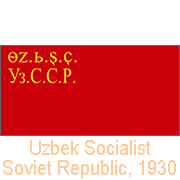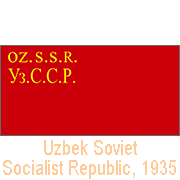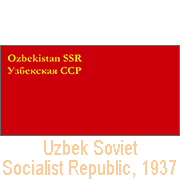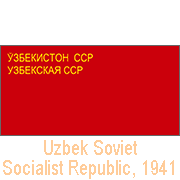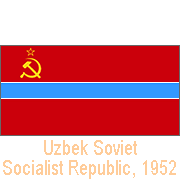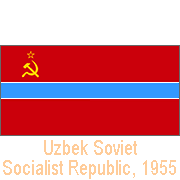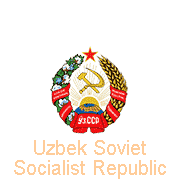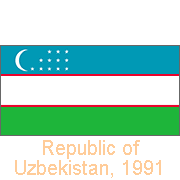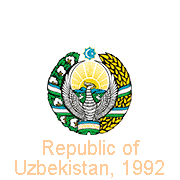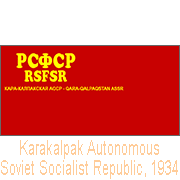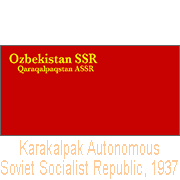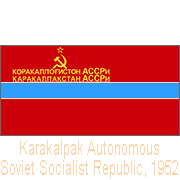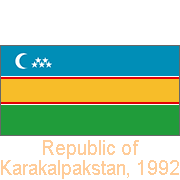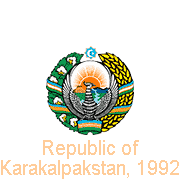Flags from Uzbekistan
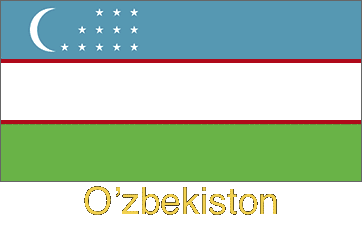
A Flag history of Uzbekistan
In the 13th century CE the Golden Horde, originally a Mongol and later Turkicized khanate was established in the northwestern sector of the Mongol Empire and including Khwarezm, the most western part of present-day Uzbekistan; it has been reported it had a banner displaying the “tamga”, (seal or emblem) and the crescent symbol of Islam. In 1370 the Timurid Empire was founded in 1370 by Timur (Tamerlane) with its capital in Samarkand and including present-day Uzbekistan except Khwarezm; its banner apparently displayed three red bezants (heraldic designs based on gold coins) on a black background, with a white fringe.
you may then send it as a postcard if you wish.
After the demise of the Timurid Empire the Khanate of Bukhara was established in 1550; it became an Emirate in 1785 which lasted until 1920. The only known flag from this period was the elaborate Royal Standard of the last Emir, Alim Khan. Meanwhile, in the western Khorezm area the Khanate of Khiva had existed since 1511. It was conquered by the Russian Empire in 1873 and became a quasi-independent Russian protectorate. It is not certain, but a white flag with a light blue crescent may have existed during that time. Meanwhile, the Khanate of Kokand in the western Fergana Valley had been established in 1709 but was annexed by the Russian Empire in 1883, becoming part of the vast territory of Russian Turkestan; there are no known flags of this period.
After the Russian Revolution in 1917 there were also calls for reform in the traditional lands of Central Asia. In 1917 an anti-Bolshevik Kokand Autonomous State was proclaimed, hoisting a flag of red over dark blue with a white star and crescent in the centre. This lasted until 20 February 1918 when Soviet troops demolished much of Kokand and massacred thousands of its people. In Khiva a civil war broke out in 1917, between pro- and anti-monarchists; the latter joined with the Bolshevists and in 1920 Khiva's last Khan, Sayid Abdullah, abdicated, the Khanate was abolished and the Khorezm People's Soviet Republic was declared. During this civil war a flag consisting of a black field within broad green stripes and a yellow crescent and star in its centre, was flown, followed by a flag showing a yellow crescent and star on a red field, with a green border and a red flag with, in a green canton, a yellow crescent and star; its points pointed towards the fly or upwards. This changed in 1922 when, in the canton, also a crossed spade, sickle and cotton plant appeared. In 1923 the country’s name changed to Khorezm Socialist Soviet Republic and its flag took on much more of a communist and Soviet symbolism.
When in 1920 the last Emir of Bukhara, Alim Khan, fled, the Bukharan People's Soviet Republic was established. It was reported there was a red flag with a crescent in the centre and the initials of the state, BNSR in Russian Cyrillic the hoist, in white or gold. That same year a flag, green over red with, in gold, the crescent and star appeared; both the green colour and the crescent and star are associated with Islam. In the hoist the initials of the state, in gold, were now in the Uzbek “Yanga imlâ” Arabic script: BKhShJ (Buxoro Xalq Shoʻro Jumhuriyati). A year later a small red hammer and sickle emblem appeared inside the gold star, combining Islamic and Soviet symbols. The initials of the state were again in Russian Cyrillic: BNSR (Bukharskaya Narodnaya Sovyetskaya Respublika). On 11 October 1923 a new constitution was adopted and the background of the flag was changed to red, with the initials of the state’s name, in gold, again in the Uzbek “Yanga imlâ” Arabic script. A year later, on 19 November 1924 the name of the state was changed to the Bukharan Soviet Socialist Republic and 5 days later it was incorporated in the Uzbek SSR.
On 30 April 1918, following the Russian revolution of 1917, the Bolsheviks in Tashkent created the Turkestan Socialist Federative Republic, soon renamed the Turkestan Autonomous Soviet Socialist Republic (ASSR), an autonomous republic of the Russian Soviet Federative Socialist Republic. Its flag, possibly dating from 1919, was plain red with in the upper hoist in yellow, the letters “TASSR” in both Yanga imlâ Arabic lettering and Russian Cyrillic. Meanwhile in September 1921 the Union of Central Asian Islamic National Insurgent Organisations instituted an all-Turkestani flag, with nine alternating red and white stripes, an orange rectangle bearing a white star and crescent and a narrow light-blue border around it. This very popular flag was used until January 1924 when the last part of Turkestani territory fell to the Red Army. It was associated with the Basmachi movement, an uprising, since 1916, against Russian Imperial and Soviet rule by the Muslim peoples of Central Asia. Because the Bolsheviks excluded the Muslim people, they battled against Soviet rule.
On 27 October 1924 the Uzbek SSR was proclaimed, one of the 5 Soviet Socialist Republics created along ethnic lines as determined by Joseph Stalin, Vladimir Lenin’s Commissar for Nationalities, out of the Turkestan and the Bukharan and Khorezm Soviet Republics. Its capital was in Samarkand until 1930. The flag was red with in the canton the abbreviation of the republic’s name, Uz.S.S.R., in both Yanga imlâ Arabic lettering (in which Uzbek was written) and Russian Cyrillic, surrounded by a thin border, all in yellow. It included the Tajik ASSR, that had its own flag, until 1929, when that autonomous republic was upgraded to a full SSR. In 1928 the modified Arabic script, Yanga imlâ, was abolished in the Soviet Union and the Latin “Yangalif” (New Alphabet), that had been developed since 1924, was now mandated; the flags were changed accordingly. This lasted until 1941 when the Latin scripts were abolished and Cyrillic was mandated, causing the flags to be changed accordingly. In 1952 all Soviet Socialist Republics obtained flags with striped designs, based on the red flag of the USSR with at the upper hoist the hammer and sickle emblem in gold, with above it a gold-fimbriated red star. The new flag for the Uzbek SSR was adopted on 29 August 1952 and displayed a light blue horizontal stripe through the centre, with white fimbriation. The flag was slightly changed after the hammer and sickle emblem was redesigned.
On 20 June 1990 the Uzbek SSR became a sovereign state within the USSR and on 31 August 1991 it declared independence as the Republic of Uzbekistan. A new flag was adopted on 18 November 1991: light blue over white over light green, with thin red stripes separating the three stripes. In the upper hoist is a white crescent and 12 white stars. Those may stand for Islam (or the rebirth of the nation) and the 12 districts of Uzbekistan; another interpretation is the zodiac and the historical traditions of the Uzbek people, as well as the ancient solar calendar. Blue stands for water as a source of life, white for peace, green for nature and red for the life force; there are other interpretations as well. The autonomous Republic of Karakalpakstan, that had been added to Uzbekistan in 1936 and whose flags had also changed over the years, adopted a flag, similar to that of Uzbekistan, but with an ochre band as the central stripe and 5 stars, standing for the 5 districts of Karakalpakstan. The State emblems are similar too and retain some elements from the Soviet-era emblems.



